The Boxcar Challenge Unit
Integrating Engineering Design, Science, and Literacy for Kindergarten
Science and Children—January 2020 (Volume 57, Issue 5)
By Kirsten D. Edwards, Amelia Wenk Gotwals, and Tanya S. Wright
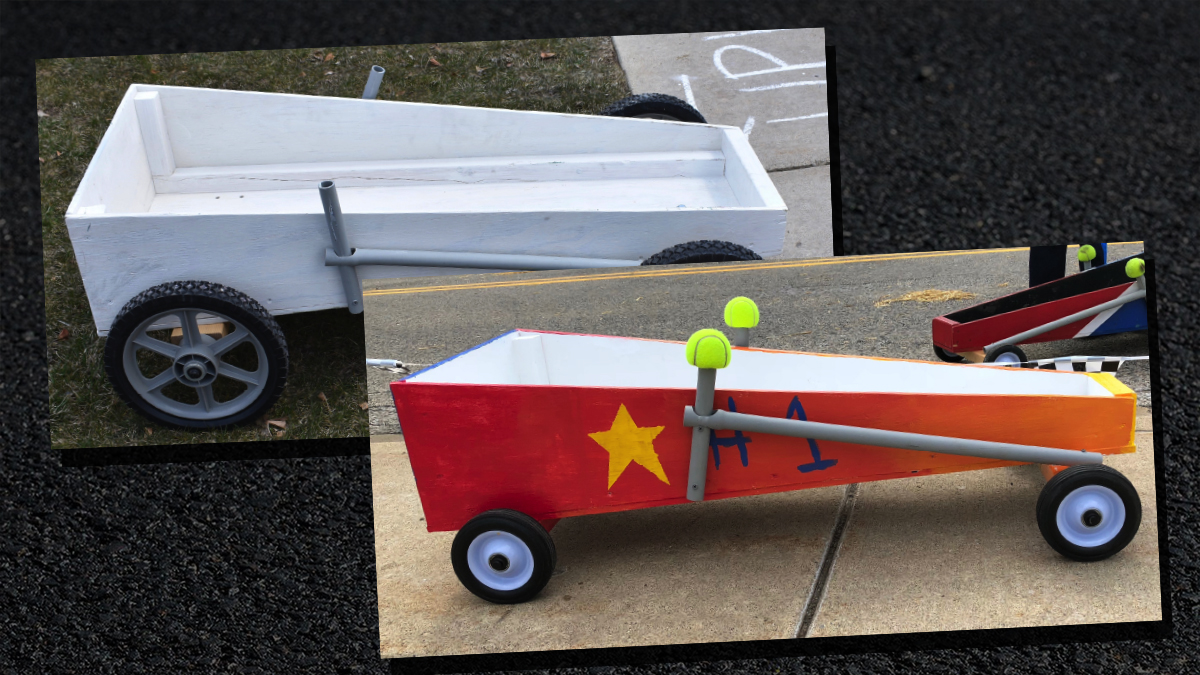
Young children love opportunities to build, discover, and solve problems. Teachers can take advantage of these natural tendencies by introducing students to aspects of engineering design while they engage in classroom activities. Finding ways of integrating engineering into our teaching is important because the Next Generation Science Standards (NGSS) include engineering as an essential component of the science curriculum (NGSS Lead States 2013). There are many ways we can tap into students’ natural curiosities about engineering, including using engineering as a lens to explore disciplinary core ideas (DCIs) and crosscutting concepts (CCCs) and engaging in science and engineering practices (SEPs). By integrating engineering design with other science learning, we can provide opportunities for students to use design processes to deepen their understandings about science.
Engineering also lends itself to supporting students in developing disciplinary literacy practices such as learning from informational text read-alouds and engaging in structured writing and talking opportunities, which are part of the Common Core State Standards for English Language Arts (CCSS ELA; NGAC and CCSSO 2010). In this article we overview a coherent unit designed to support students in engaging in engineering practices to deepen their understanding of the kindergarten physical science performance expectations (PEs). Then we provide examples of key activities from the unit that supported the integration of science, engineering, and disciplinary literacy.
The Project
This unit is part of SOLID Start (Science, Oral Language, and LIteracy Development from the Start of School), which supports teachers in enacting ambitious science discourse in their classrooms to deepen science learning and promote science language development (Wright and Gotwals 2017). In the project curricular units, students are presented with a puzzling phenomenon and driving question and then, through a series of coherent activities, they build and revise their understandings of how and why things happen. The curricula focus on five key instructional strategies: Ask, Explore, Read, Write, and Synthesize. When teachers used these curricular units, children were significantly more likely to provide scientific arguments (i.e., making and supporting claims) and use science vocabulary when responding to questions compared to their peers in classrooms that did not use the curricula (Wright and Gotwals 2017).
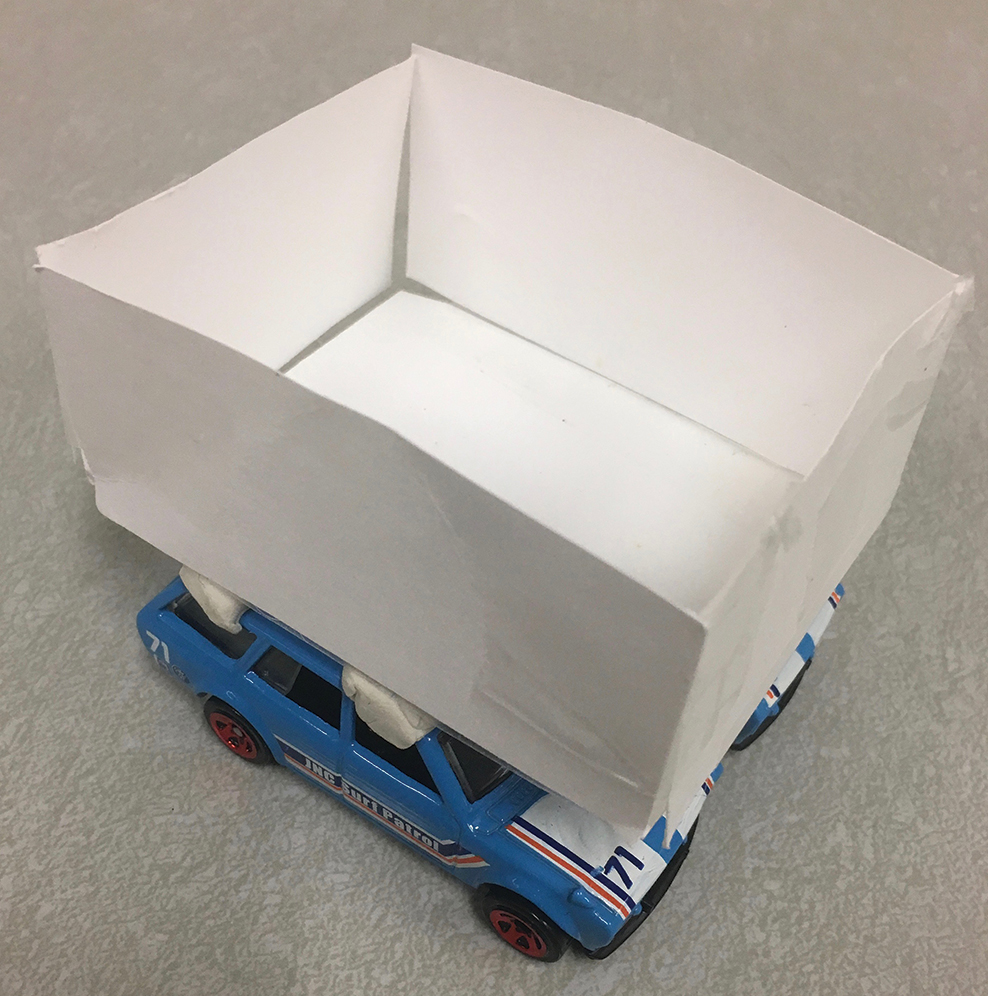
The Boxcar Challenge Unit
In the following subsections, we walk through activities from SOLID Start’s Boxcar Challenge Unit. In this unit, students first watch a short video of a soapbox derby where they see children attempting to make their boxcars move fast and hear children talk about the experience. This video serves to engage students with a phenomenon and introduce the engineering challenge, which is how to make a boxcar move fast, far, and around an obstacle. Following the introduction to the engineering design challenge, students work through a series of activities that help them build an understanding about pushes and pulls (i.e., the DCIs) that will support them in designing a solution to this problem. Here, we provide examples from the beginning, middle, and end of the unit from Mrs. Sullivan’s kindergarten classroom to highlight the engineering design process and opportunities to support students’ disciplinary literacy development. See Figure 1 for a list of materials used in the described lessons.
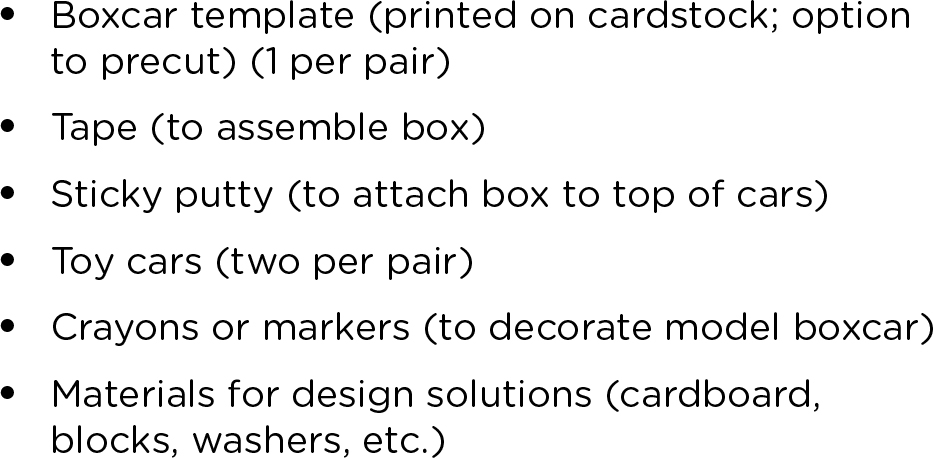
Mrs. Sullivan taught this unit in the middle of the school year; however, the students had limited science lessons in kindergarten prior to the enactment of this unit. Mrs. Sullivan taught the 10 lessons over the course of one month, teaching two or three lessons per week. The lessons were about one hour long, with some lessons taught over two days.
Throughout the unit, Mrs. Sullivan kept track of students’ learning using a table with students’ names and three assessment statements aligned with the NGSS PEs (Figure 2).
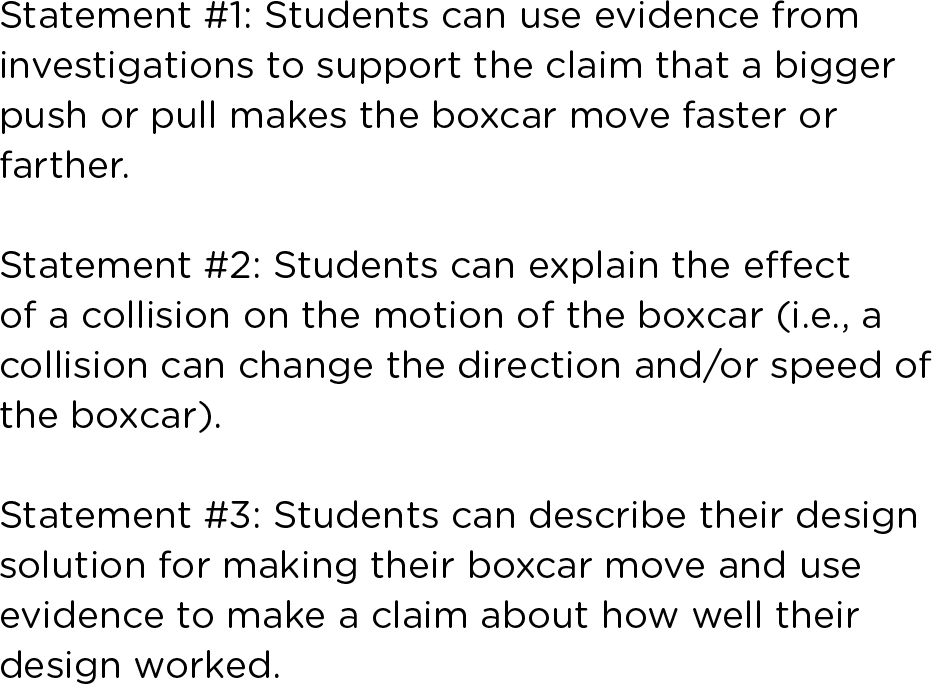
In each lesson, Mrs. Sullivan noted what students said, did, or wrote as evidence of student understanding. By allowing students to share their understandings in multiple modalities (e.g., verbally, written) at different points, she gave all students opportunities to demonstrate their understanding in ways that worked for them.
Unit Introduction
Integrating Engineering
The initial lessons of the Boxcar Challenge Unit serve to introduce the driving question, anchoring phenomenon, and engineering design challenge. The introduction of an engineering design challenge is a great place to engage with the SEP of asking questions and defining problems. After watching the boxcar video in Lesson 1, Mrs. Sullivan asked her students what questions they had and what they wanted to know about a boxcar derby.
Mrs. Sullivan: After watching the boxcar derby, what questions or wonderings do you have?
Alecia: Does it [the boxcar] always have to look the same?
Tony: I wonder how it keeps going.
Sarah: Yeah…things always just stop without an engine…
Ben: I wonder how he pushed [the boxcar] so it goes…
Mrs. Sullivan recorded these questions and wonderings on a Driving Question Board and returned to them throughout the unit. By providing students opportunities to ask questions about the phenomenon of the boxcar derby, she piqued students’ curiosity related to the engineering design challenge. She was also able to use this as a formative assessment opportunity to determine what students already knew about how things move (the DCI), which she recorded in the assessment table.
Disciplinary Literacy
Engineering design also provides many opportunities to support students’ disciplinary literacy development. After asking questions about the boxcar derby and exploring motion with toys, Mrs. Sullivan introduced students to the boxcar design challenge (i.e., how to make a boxcar move fast, far, and around an obstacle) in Lesson 3. Students brainstormed ideas in small groups while drawing and writing their initial design solutions. Mrs. Sullivan then scaffolded students in giving feedback to their classmates by providing sentence frames including “I agree/disagree with ____’s idea because________.” Sentence frames support students in sharing their ideas as scientists and engineers would. This apprenticing into the language of science and engineering is a component of disciplinary literacy as students begin to learn how to move toward supporting their claims with evidence and reasoning rather than using their opinions. In addition to promoting disciplinary literacy, sentence starters also support students in engaging in argument from evidence. An example of this includes when one group presented their idea of making the starting ramp that the boxcar is on higher.
George: I agree with their idea because higher means going faster, like a sled.
Ashley: I agree too because higher will make it go faster and farther.
John: I disagree with them because our group said you should push the car more times.
Mrs. Sullivan: Could both of those solutions work?
John: No, ours is going to be make it go faster. [A lot of talking]
Mrs. Sullivan: Okay, okay, well we don’t know yet, right? We are going to investigate these ideas.
By providing sentence starters, Mrs. Sullivan allowed multiple ideas and designs to be presented and discussed at the beginning of the unit and set up the investigations that students would do throughout the unit.
Unit Investigations
Integrating Engineering
Following the brainstorming of design solutions, students needed a way to test them in the classroom. Because real boxcars are too big for the classroom, students engaged in the engineering practice of building models in Lesson 4. Students built their model boxcars by placing a small open box made of cardstock on top of two toy cars (See Supplemental Resources for a template). Specifically, students taped together the precut template to form an open box and then used sticky putty to attach the open box to two toy cars. In this case, Mrs. Sullivan cut out the templates, but teachers could support fine motor skill development if they had students use safety scissors to cut out the templates.
Students then used their model boxcars to figure out how different factors influence how boxcars move. Aligned with the kindergarten physical science DCIs as well as students’ initial ideas and designs, students engaged in four investigations. The four investigations were focused on pushes, pulls, weight, and collisions in Lessons 5, 6, 7, and 8. They recorded their findings on a Summary Table, which serves to support students in synthesizing their findings across investigations and informational texts (see Figure 3, p. 49).
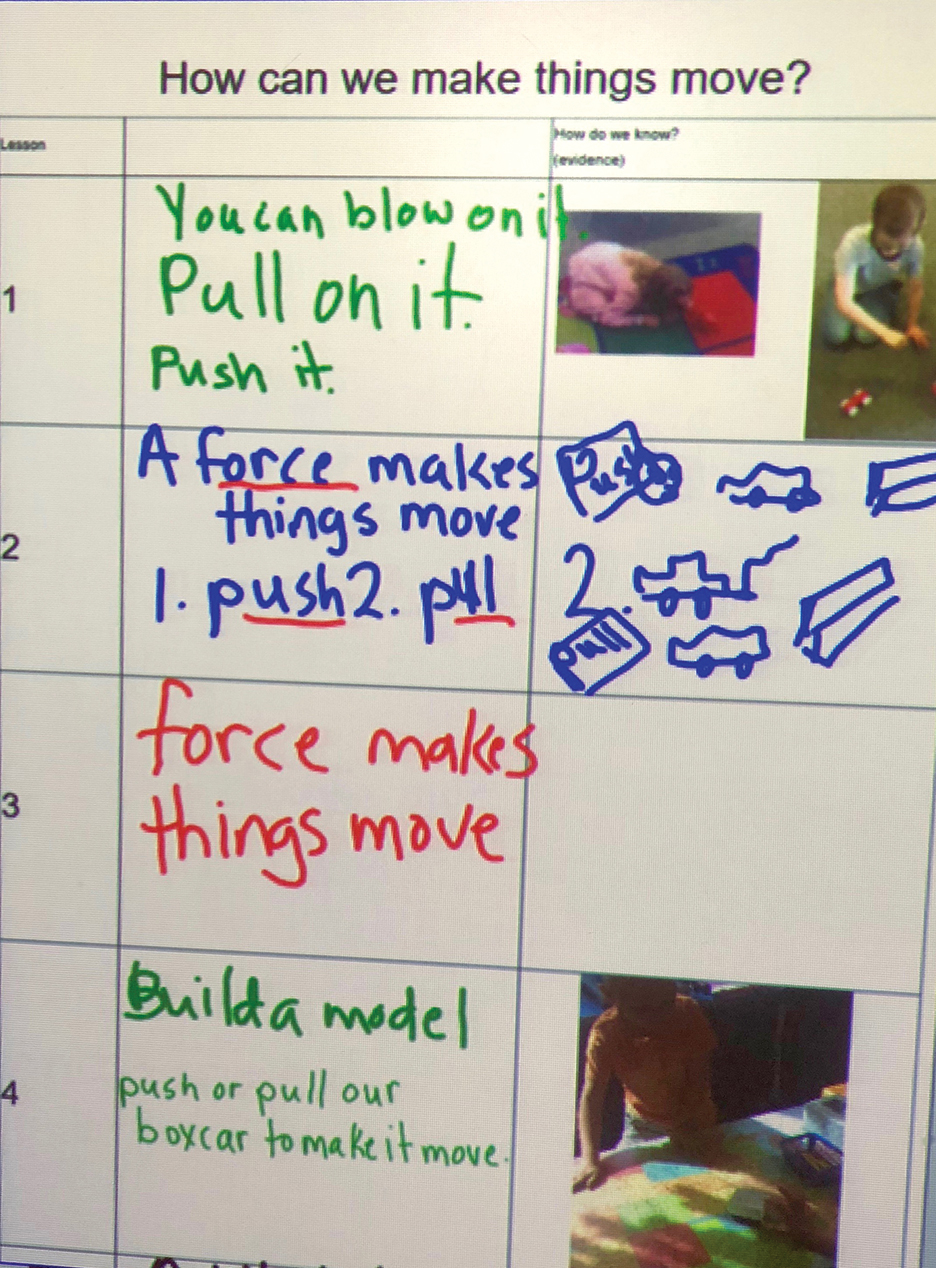
After watching the boxcar video, students wondered how the type of initial push affects the boxcar, so they engaged in the SEP of planning and carrying out investigations. To understand a “fair test,” Mrs. Sullivan first led the students in conversation about what is and is not fair, such as it is not fair to give one person a head start in a race. Then, for the investigation in Lesson 5, the students were guided in pushing their model boxcars first with one finger and then with their whole hand in different trials. To ensure things went smoothly (i.e., to support classroom organization), Mrs. Sullivan assigned students to work in pairs and students took turns with two roles: (1) pushing the car and (2) recording the data. This allowed all students the opportunity to engage with the investigation in multiple ways. Students also had opportunities to make sense of the investigation verbally with their partners and the whole class, as well as by recording their ideas on their investigation sheets. For safety, the teacher reminded students to keep the wheels of their model boxcars on the ground.
Students determined the effect of the strength of the push on the speed and distance that the box car traveled. They then engaged in teacher-supported writing to record their results. The active nature of the investigation and the supported writing opportunities provide a natural way of differentiation, allowing students with a wide range of understandings to engage in sensemaking about the investigation. Mrs. Sullivan recorded evidence of students’ understanding in the assessment table, such as if they demonstrated understanding that a harder push made the boxcar move farther (Assessment Statement #1).
Disciplinary Literacy
In order to support students in acquiring disciplinary oral language, the unit incorporates interactive informational text read-alouds to accompany the investigations. To accompany the push investigation in Lesson 5, Mrs. Sullivan read part of Move It! Motion, Forces, and You (Mason 2005). An interactive read-aloud of an informational text serves multiple purposes, including supporting students in meeting the CCSS ELA related to identifying main details in an informational text and the NGSS SEP of obtaining information.
Read-alouds are places where key vocabulary is introduced and the teacher can support students in talking like engineers and scientists using their new knowledge. Students used the results of their investigations as well as ideas presented in the text to construct explanations about the relationship between the strength of a force and the distance or speed of the boxcar (SEPs: Planning and Carrying Out Investigations, Obtaining, Evaluating and Communicating Information, Constructing Explanations; CCCs: Patterns, Cause and Effect). In a conversation following the investigation and read-aloud, Mrs. Sullivan supported students in using their new vocabulary words and constructing explanations.
Sarai: When we pushed it with our whole hand…it moved farther.
Mrs. Sullivan: What else do we know from our investigation?
Ben: The boxcar moved slower when I pushed with my finger….
Mrs. Sullivan: What did we learn from our book? What is a push a type of?
Multiple students: A force!
Mrs. Sullivan: Okay, so who can tell me what we learned about forces today?
Ashley: The hand was a big force and the finger was small.
Tom: The hand force was big and made the boxcar go faster.
Oral vocabulary development is recognized in A Framework for K–12 Science Education (NRC 2012) as an important part of science and engineering learning as it enables students to communicate their scientific ideas while engaging in SEPs and using CCCs and DCIs (Wright and Domke 2019).
The Engineering Design Challenge
In the final lessons of the unit, Lessons 9 and 10, students are supported in using what they have learned about how things move to plan and test solutions to make their boxcar move fast, far, and through an obstacle course. Mrs. Sullivan reviewed the engineering design cycle through an interactive read-aloud of part of Engineers Solve Problems (Miller 2014). As with other informational text read-alouds in the unit, the read-aloud supports disciplinary literacy practices related to SEPs.
The students then engaged in making plans. Students first shared ideas with a partner and then drew their ideas on a student sheet. Mrs. Sullivan circulated while the students worked on their plans.
Mrs. Sullivan: Do you have ideas?
John: If we want it to go fast, start it here…
Mrs. Sullivan: …and use a ramp. I see your drawing of a ramp.
Talking with another group, Mrs. Sullivan questioned how students would move their boxcar around the blocks in the third challenge.
Mrs. Sullivan: How will you make it turn?
Tony: A ramp like that [Tony points diagonally.]
Sarah: Or another block it could collide with.
The students used understandings built from investigations and texts to inform their plans (e.g., DCI PS3.C; SEPs: Designing Solutions, Obtaining, Evaluating, and Communicating Information; CCCs: Patterns, Cause and Effect). They also engaged in the disciplinary literacy practices of engineers by creating a plan that included both words and drawings (see Figure 4, p. 50). The students shared their plans with each other and offered both encouragement and critique. In line with the engineering DCI ETS1.A, students see that there are multiple possible solutions to the problem that have different advantages and drawbacks.
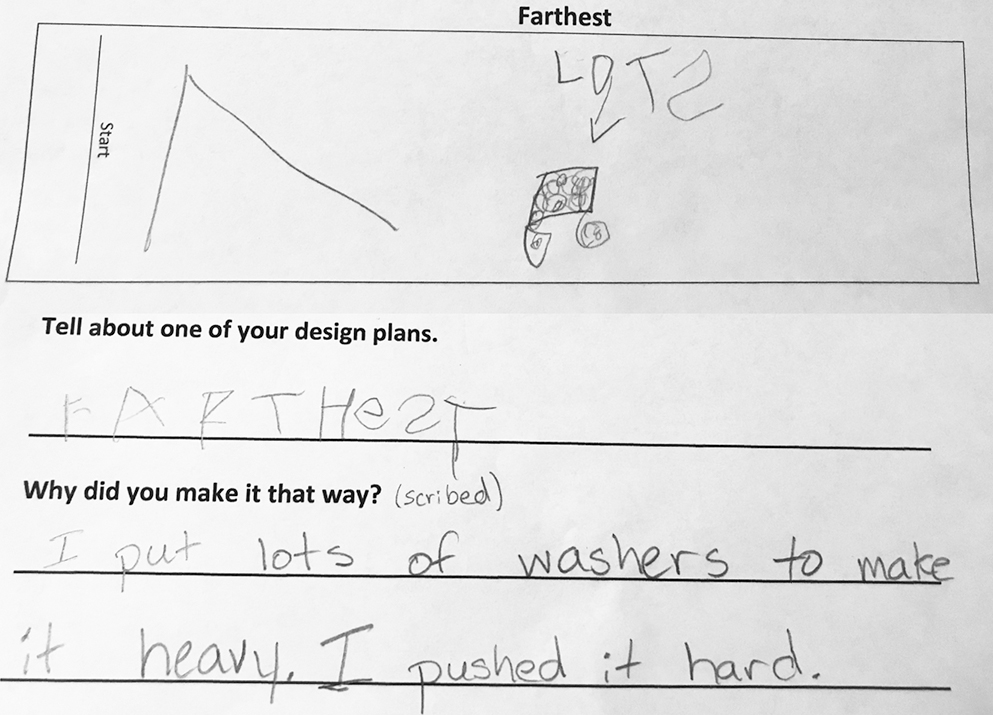
Students were then given the opportunity to test their design plans in a boxcar derby. Students set up their designs, including the options of placing a ramp at the start, filling their boxcar with washers, and pushing harder or softer. Students then tested their designs using their model boxcars and recorded the results. They were given the opportunity to see their peers’ designs and how they worked. After all students tested their designs, they had a class discussion in which, with the support of sentence starters, students determined which designs worked best for what purposes (SEP: Engaging in Argument From Evidence). Mrs. Sullivan again recorded students’ understanding in the assessment table, now considering if students met each of the three assessment statements. An extension of the unit could involve having students revise their design plans and retest their model boxcars based on the results of the initial trials.
Conclusion
The Boxcar Challenge Unit provides an example of how we can use engineering design problems to engage students in three-dimensional science learning and to build their disciplinary literacy practices. In order to optimize their design solution, students must build understandings of how and why things happen. Thus, finding exciting science and engineering phenomena that students are curious about and will want to explore is a great way to integrate engineering into our science classrooms.
ACKNOWLEDGEMENT
This material is based upon work supported by the National Science Foundation under Grant No. DRL-1620580. Any opinions, findings, and conclusions or recommendations expressed in this material are those of the authors and do not necessarily reflect the views of the National Science Foundation.
Engineering Literacy Elementary


